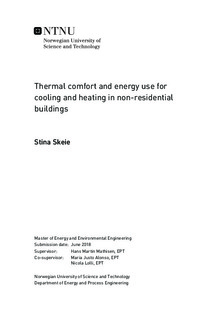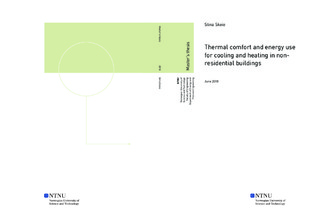| dc.description.abstract | Indoor environmental quality is important as 90% of time is spent indoors. Otherwise consequences can be reduced performance of work or fostered illnesses. Contrary, the building sector is responsible for 40% of the total energy use in the world. There is a need for measures with immediate effect. This thesis examines user controllability of the indoor environment in correlation to thermal comfort and energy use. It is of interest as energy performance of buildings is suggested to be influenced by user behaviour. Field work was carried out at the ZEB Test Cell Laboratory in Trondheim and simulations completed in IDA ICE. Accordingly, this thesis is a contribution to the field of research covering a cold climate. Experiments gathering measurements and questionnaires were carried out simultaneously in two separated but identical office cells, automatic and manually operated, with one occupant in each cell. The experiment was based on a low number of participants due to being postponed until May. Hence, no general conclusions could be drawn. Although, comparing findings to relevant literature showed reappearing trends.
Key findings showed a difference in thermal sensation votes. The occupant in the manual cell perceived the thermal environment as neutral, whereas the participant in the automatic cell voted slightly warm throughout large portions of the relevant day. Accordingly, the participant in the automatic cell rated temperatures above 25.6°C just acceptable whilst the occupant in the manual cell perceived the temperature as clearly acceptable throughout the entire day with the highest temperature at 25.9°C. This resulted in a difference in perceived maximal temperature of 0.3°C. Deviations could be due to operating strategies. User control ensures that occupants more actively can optimize conditions directly based on individual preferences. Simulations were completed on the case day calculating standard comfort indices in accordance with Fanger`s model. Concurrence between calculated and observed votes were most evident for the computer operated cell. Standard calculations failed to predict thermal sensation for the manual cell. Votes were not slightly cool as calculated in IDA ICE, but in reality neutral and slightly warm.
User behaviour and its effect on energy use was researched by simulating four window opening strategies in IDA ICE. That is 1) always open, 2) never open, 3) based on season, indoor and outdoor temperature and CO2 and 4) as registered during experiments in the manual cell. The greatest difference in heating consumption resulted in a percentage change of 499% between strategy 1) and 4). A lower percentage change at 192% was found when comparing strategy 3) and 4). Fixed setpoints were applied for the radiator when modelling all four strategies. In reality occupants are assumed to turn off the radiator thermostat if windows are opened and not pursue a conflicting operating strategy as modelled.
Multivariable regression analysis in Excel showed that window opening events in the manual cell were correlated to operative temperature, outdoor temperature, CO2 level and solar radiation with the following model. The parameters explain 78% of the variability in window opening percentage. The outdoor climatic parameters resulted in the lowest probability values and accordingly higher significance.
y = -207.25 + 4.67*Top + 2.74*Tout + 0.14*CO2 + 0.04*Irad | |

